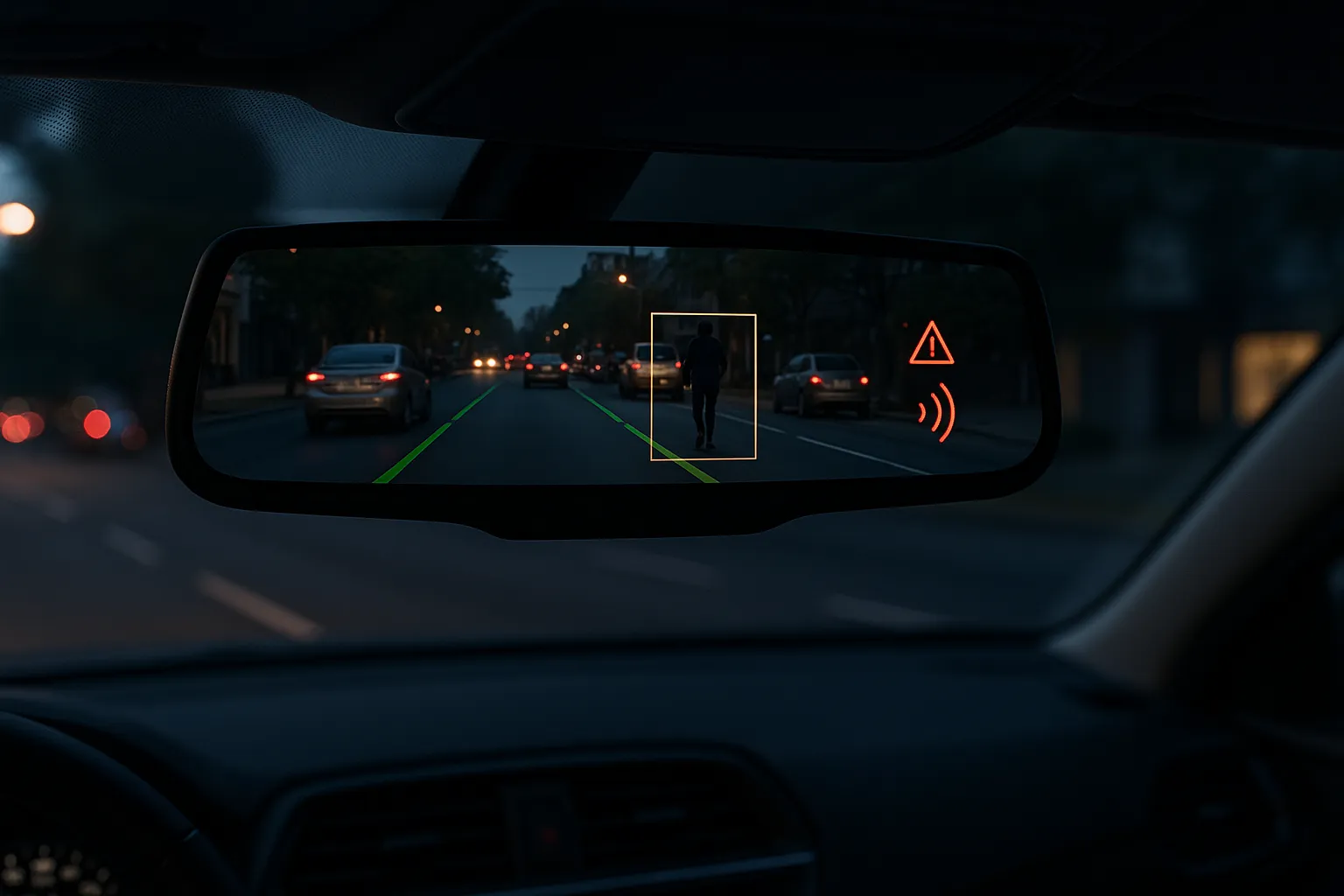In today’s automotive world, cars are becoming smarter and safer than ever. Every year, new technologies make driving more intuitive. One of the most interesting examples is the
OEM original rear view mirror monitor[^1]— a device that turns a simple mirror into an intelligent display system.
If you’re an automotive manufacturer or supplier looking to understand how OEM mirror monitors work, what benefits they bring, and how to choose the right partner, this guide is for you.

The idea behind an OEM mirror monitor is simple but powerful — combining traditional reflection with digital vision. In this article, I’ll walk you through how these systems are built, their technical strengths, and what really matters when choosing a reliable OEM supplier.
What Is an OEM Original Rear View Mirror Monitor?
An OEM (Original Equipment Manufacturer) rear view mirror monitor is a display unit designed to fit seamlessly into a specific car model. It’s not an off-the-shelf add-on but part of the vehicle’s original design.
Unlike aftermarket products, OEM versions match every detail — from screen size and interface type to housing shape and firmware compatibility.
They’re often used as reversing displays, digital smart mirrors, or AI-assisted vision systems, giving drivers clearer, safer, and smarter views of what’s behind or around the vehicle.

Because these monitors are fully integrated into the vehicle’s wiring and design, they deliver a clean, factory-grade appearance while keeping performance stable even under tough conditions.
Key Features and Technical Advantages
Modern OEM mirror monitors go far beyond simple video screens. Today’s systems combine high-end optics, electronics, and intelligent control technologies.
Here are some of the most common features you’ll find:
-
High brightness and anti-glare screens for clear viewing under strong sunlight.
-
Auto-dimming and anti-flicker[^2] for comfortable night driving.
-
Multi-format inputs that support AHD, CVBS, HDMI, or LVDS video signals.
-
Touchscreen operation and split-screen display for better visibility of multiple camera angles.
-
Built-in DVR and ADAS support that allow recording and driver-assistance alerts in one device.
These features transform the mirror from a passive tool into a core part of the vehicle’s safety and design ecosystem.

OEM Customization Options for Car Makers
No two car models are the same, and that’s where OEM customization comes in. Most automakers want mirror monitors that match their brand look and system architecture perfectly.
A capable OEM supplier can provide options such as:
- Design customization: shape, housing color, curvature, and mounting structure.
- Functional customization: video input setup, Bluetooth, microphone, touch panel, or recording functions.
- Software/UI customization: boot logo, animation, OSD menu, and language selection.
- Quality assurance: IATF16949, EMC, CE, and E-Mark compliance.
These options make it possible to create a mirror that feels truly built-in, not added later — one that matches the car’s identity both technically and visually.
Applications and Integration Scenarios
OEM mirror monitors aren’t limited to passenger cars. They’re now widely used in commercial trucks, buses, agricultural vehicles, and even construction equipment.
- Passenger vehicles: as parking and reversing aids.
- Heavy trucks: for continuous rear monitoring.
- Off-road or construction vehicles: to eliminate blind spots and improve job site safety.
They also connect easily with rear cameras, DVRs, and 360° AVM systems, forming a complete vision solution that helps both drivers and fleet operators work with more confidence.
The Difference Between OEM and Aftermarket Mirror Monitors
Although both types display rear images, the difference between OEM and aftermarket units is huge.
| Aspect | OEM Mirror Monitor | Aftermarket Mirror Monitor |
|---|---|---|
| Design Fit | Perfectly matches vehicle interior | Universal fit, less refined |
| System Integration | Works with factory wiring and ECUs | Often needs modification |
| Reliability | Automotive-grade materials and testing | Quality varies widely |
| Cost | Higher cost but longer lifespan | Cheaper but less stable |
In short, OEM monitors focus on reliability and perfect integration, while aftermarket ones prioritize flexibility and lower cost. If you’re building vehicles in volume or for brand customers, OEM is the clear choice.

How to Choose a Reliable OEM Supplier in China
China is home to many excellent automotive electronics factories, but not all are equal. From my experience, here are the main things to check when selecting an OEM mirror monitor supplier:
- R&D strength: an in-house team that handles hardware, software, and mechanical design.
- Production capability: their own molds and assembly lines to ensure precision.
- Testing process: vibration, temperature, humidity, and EMC tests should all be standard.
- Certifications: IATF16949 and ISO9001 are must-haves for automotive supply.
- Client track record: previous cooperation with known car brands shows reliability.

A strong OEM partner will not only build good hardware but also help you shorten development cycles, manage risks, and ensure long-term stability for your product line.
Future Trends in OEM Mirror Monitors
The mirror monitor of the future won’t just display — it will think. Several exciting trends are already shaping this market:
- AI-powered vision systems for pedestrian and lane detection.
- Camera Monitor Systems (CMS) replacing optical mirrors entirely.
- Full digital integration with ADAS and connected vehicle networks.
- Wireless video transmission for simpler installation.
- Cloud and OTA updates for remote diagnostics and feature upgrades.
| Trend | Description | Impact on Automakers |
|---|---|---|
| AI-Powered Vision | Integration of AI algorithms for pedestrian, vehicle, and lane detection. | Enhances safety and enables smarter driver assistance systems. |
| Camera Monitor Systems (CMS) | Replacement of traditional optical mirrors with digital camera displays. | Expands visibility, reduces blind spots, and improves vehicle aerodynamics. |
| Full Digital Integration | Connection with ADAS, AVM, and in-vehicle networks. | Creates a unified smart cockpit and seamless data communication. |
| Wireless Video Transmission | Utilizing 5G or Wi-Fi to transmit high-definition video signals. | Simplifies installation and reduces wiring complexity. |
| Cloud Connectivity & OTA Updates | Support for remote diagnostics, firmware updates, and cloud-based monitoring. | Extends product life and allows continuous software optimization. |
| Frameless & Ultra-Thin Design | Sleek form factors with minimal bezels and lightweight construction. | Aligns with modern interior aesthetics and enhances user experience. |
As vehicles move toward automation, the mirror monitor is becoming a smart interface — not just for viewing, but for real-time decision-making.
Why Choose VST Tech as Your OEM Mirror Monitor Partner
At VST Tech, we’ve been developing and manufacturing rearview cameras, mirror displays, and 4G AI dash cams for years. We understand what automakers expect — and what end-users really value.
Here’s why global brands choose to work with us:
- Full OEM & ODM customization for any vehicle platform.
- Strict quality control and 100% functional testing.
- Fast product development with an experienced R&D team.
- Proven cooperation record in Asia, Europe, and the Americas.
If you’re planning a new vehicle project or upgrading your current mirror system, our team can help you design a solution that looks great, performs reliably, and aligns with your brand’s vision.
Conclusie
OEM rear view mirror monitors[^3] are more than display tools — they’re a bridge between safety, design, and intelligence. As vehicles continue evolving, the mirror will remain a central point of innovation. Partnering with the right supplier can make all the difference between a standard component and a signature feature that defines your brand.


